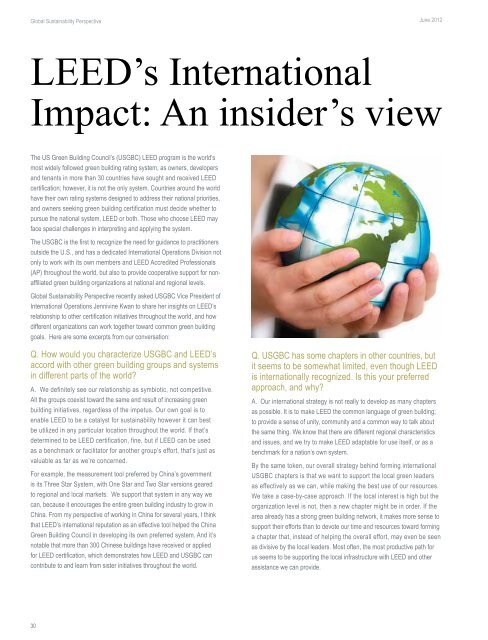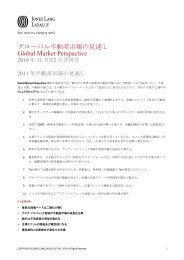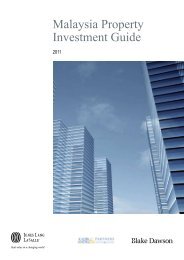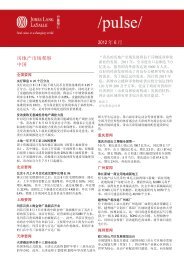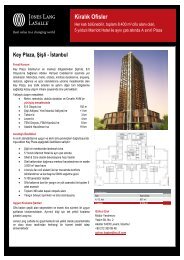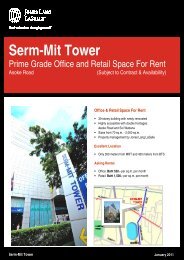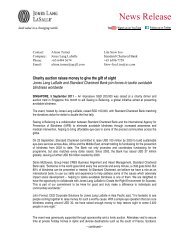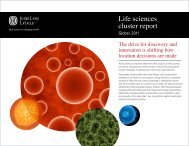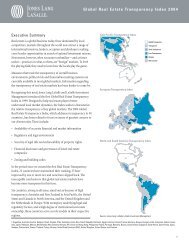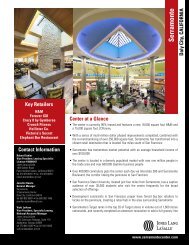Global Sustainability Perspective magazine - Jones Lang LaSalle
Global Sustainability Perspective magazine - Jones Lang LaSalle
Global Sustainability Perspective magazine - Jones Lang LaSalle
Create successful ePaper yourself
Turn your PDF publications into a flip-book with our unique Google optimized e-Paper software.
<strong>Global</strong> <strong>Sustainability</strong> <strong>Perspective</strong><br />
The US Green Building Council’s (USGBC) LEED program is the world’s<br />
most widely followed green building rating system, as owners, developers<br />
and tenants in more than 30 countries have sought and received LEED<br />
certification; however, it is not the only system. Countries around the world<br />
have their own rating systems designed to address their national priorities,<br />
and owners seeking green building certification must decide whether to<br />
pursue the national system, LEED or both. Those who choose LEED may<br />
face special challenges in interpreting and applying the system.<br />
The USGBC is the first to recognize the need for guidance to practitioners<br />
outside the U.S., and has a dedicated International Operations Division not<br />
only to work with its own members and LEED Accredited Professionals<br />
(AP) throughout the world, but also to provide cooperative support for nonaffiliated<br />
green building organizations at national and regional levels.<br />
<strong>Global</strong> <strong>Sustainability</strong> <strong>Perspective</strong> recently asked USGBC Vice President of<br />
International Operations Jennivine Kwan to share her insights on LEED’s<br />
relationship to other certification initiatives throughout the world, and how<br />
different organizations can work together toward common green building<br />
goals. Here are some excerpts from our conversation:<br />
Q. How would you characterize USGBC and LEED’s<br />
accord with other green building groups and systems<br />
in different parts of the world?<br />
A. We definitely see our relationship as symbiotic, not competitive.<br />
All the groups coexist toward the same end result of increasing green<br />
building initiatives, regardless of the impetus. Our own goal is to<br />
enable LEED to be a catalyst for sustainability however it can best<br />
be utilized in any particular location throughout the world. If that’s<br />
determined to be LEED certification, fine, but if LEED can be used<br />
as a benchmark or facilitator for another group’s effort, that’s just as<br />
valuable as far as we’re concerned.<br />
For example, the measurement tool preferred by China’s government<br />
is its Three Star System, with One Star and Two Star versions geared<br />
to regional and local markets. We support that system in any way we<br />
can, because it encourages the entire green building industry to grow in<br />
China. From my perspective of working in China for several years, I think<br />
that LEED’s international reputation as an effective tool helped the China<br />
Green Building Council in developing its own preferred system. And it’s<br />
notable that more than 300 Chinese buildings have received or applied<br />
for LEED certification, which demonstrates how LEED and USGBC can<br />
contribute to and learn from sister initiatives throughout the world.<br />
June 2012<br />
LEED’s International<br />
Impact: An insider’s view<br />
Q. USGBC has some chapters in other countries, but<br />
it seems to be somewhat limited, even though LEED<br />
is internationally recognized. Is this your preferred<br />
approach, and why?<br />
A. Our international strategy is not really to develop as many chapters<br />
as possible. It is to make LEED the common language of green building;<br />
to provide a sense of unity, community and a common way to talk about<br />
the same thing. We know that there are different regional characteristics<br />
and issues, and we try to make LEED adaptable for use itself, or as a<br />
benchmark for a nation’s own system.<br />
By the same token, our overall strategy behind forming international<br />
USGBC chapters is that we want to support the local green leaders<br />
as effectively as we can, while making the best use of our resources.<br />
We take a case-by-case approach. If the local interest is high but the<br />
organization level is not, then a new chapter might be in order. If the<br />
area already has a strong green building network, it makes more sense to<br />
support their efforts than to devote our time and resources toward forming<br />
a chapter that, instead of helping the overall effort, may even be seen<br />
as divisive by the local leaders. Most often, the most productive path for<br />
us seems to be supporting the local infrastructure with LEED and other<br />
assistance we can provide.<br />
Q. Is there confusion internationally about the<br />
difference between USGBC, the World Green<br />
Building Council (WGBC) and other worldwide<br />
councils and green building organizations?<br />
A. You bet. And the confusion extends beyond USGBC to LEED<br />
itself. A surprising number of outsiders think that both LEED and the<br />
USGBC are run by the U.S. government, and as such are biased<br />
toward “American” interests. Needless to say, one of most important<br />
tasks is to remove that type of misconception, and convince them that<br />
we are totally transparent in partnering toward whatever best serves<br />
their sustainable goals.<br />
And yes, we do get confused with WGBC. As the name infers, WGBC<br />
is an umbrella organization for green building councils at national,<br />
regional and local levels throughout the world. USGBC did have an<br />
important development role as one of the eight national councils that<br />
launched WGBC in 1999, and we’re gratified that with the support<br />
of WGBC, green building councils are on the ground partnering with<br />
industry and government in more than 80 countries. I think that as<br />
the market matures, so will the understanding of distinctions among<br />
LEED, USGBC, WGBC and other green building councils.<br />
Q. How do LEED practitioners share ideas in<br />
countries where LEED is not the primary system?<br />
A. Until a couple of years ago, even though we had LEED chapter<br />
members and APs in many countries, the personal motivation and sense<br />
of urgency to bond together to share information wasn’t always there.<br />
The situation has changed a lot in recent years. <strong>Sustainability</strong> has<br />
proven to be more than a fad, and it is becoming government mandated<br />
in many places. Though some markets are more mature than others,<br />
there’s a hunger for green building information at some level almost<br />
everywhere in the developed world.<br />
LEED interest has always been very much a grassroots movement. It’s<br />
a voluntary system and its practitioners are in it for their passion for<br />
sustainable living. Increasingly, I’m seeing LEED APs getting together<br />
informally with non-LEED people with green interests as professional<br />
colleagues, or just groups of friends with a shared environmental<br />
commitment. They talk about LEED and other green facilitators, sharing<br />
ideas and experiences and discussing how sustainable building can best<br />
move forward in their part of the world. It really mirrors the scenario in the<br />
US that led to the USGBC and LEED, and it’s very satisfying to see that<br />
initial enthusiasm rekindled in so many new places.<br />
30 31<br />
<strong>Jones</strong> <strong>Lang</strong> <strong>LaSalle</strong><br />
Q. Many LEED credits are based on standards set<br />
by other organizations, such as the American Society<br />
of Heating, Refrigeration, and Air-Conditioning<br />
Engineers (ASHRAE), which may not be the<br />
applicable standards in every country. How adaptable<br />
is your system in allowing standards other than<br />
ASHRAE to be used in LEED certifications?<br />
A. That’s a complex issue that USGBC is discussing right now. We really<br />
want to make LEED as flexible as possible, and one way we’re doing<br />
that is by establishing alternative paths for LEED pursuits outside the<br />
US. The challenge is to achieve this without either raising or lowering<br />
the measurement bar, because LEED’s utility is based on its consistency<br />
everywhere it is used. We look at the outcome and what we want the<br />
building to do in the end through LEED certification, rather than try to<br />
micromanage the steps in getting there. For some of the LEED credits,<br />
it’s a simple matter of a change in the credit language that enables<br />
people to use something that is an apples-to-apples equivalent.<br />
With ASHRAE, that might not be so easy. LEED is not a standard itself, but<br />
a measurement tool that relies on other standards USGBC has chosen as<br />
benchmarks for sustainable building excellence. ASHRAE is a great standard<br />
that predates the development of LEED. A lot of work went into creating the<br />
ASHRAE standards, and we don’t need to re-create it. If people want to use<br />
another standard for measurements covered by ASHRAE like the energy<br />
credits, we have to make sure that it is fully compatible with the ASHRAE<br />
standard requirements; otherwise LEED loses its validity as a measurement<br />
tool. That’s not saying that other standards might not be as demanding as<br />
ASHRAE; some may indeed be more stringent. LEED is neither the easiest<br />
nor the toughest measurement system around. What is critical is that any<br />
other international standard used must really align with the LEED standard it<br />
is replacing for our tool to remain consistent.<br />
Q. Are LEED materials available in multiple<br />
languages?<br />
A. Currently much of our information is available in English, Spanish,<br />
Chinese, Portuguese, French and Italian versions. These cover a<br />
large percentage of the world’s population, especially where there is<br />
green building going on. We’ll certainly consider other languages as<br />
the demand occurs.


